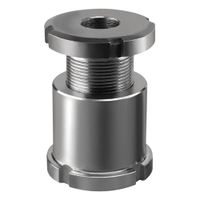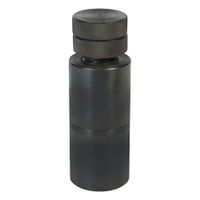Call +(254) 703 030 000 / 751 483 999 / 721 704 777
.....Read More
Frequently Asked Questions
What are machine leveling components?
Machine leveling components are essential elements used to ensure that machinery and equipment are properly aligned and stable on their supporting surfaces. These components are crucial for maintaining the precision, efficiency, and safety of machines in various industrial settings. Key machine leveling components include:
1. **Leveling Feet**: Adjustable feet that allow for height adjustments to ensure the machine is level. They often come with anti-vibration pads to reduce noise and wear.
2. **Leveling Jacks**: Devices used to lift and support machines, allowing for precise leveling adjustments. They are typically used for heavier machinery.
3. **Shims**: Thin pieces of material inserted between the machine and its base to correct minor height discrepancies and achieve a level position.
4. **Spirit Levels**: Tools used to measure the levelness of a machine. They help in identifying uneven surfaces and guide the adjustment process.
5. **Wedges**: Tapered components placed under machines to adjust their height and level them. They are often used in conjunction with shims for fine-tuning.
6. **Vibration Isolators**: Components that absorb and dampen vibrations, preventing them from affecting the machine's performance and ensuring stability.
7. **Base Plates**: Plates that provide a stable and level surface for machines to rest on. They are often used in conjunction with other leveling components.
8. **Laser Leveling Systems**: Advanced systems that use laser technology to provide precise leveling measurements and adjustments.
These components are vital for preventing misalignment, which can lead to increased wear and tear, reduced accuracy, and potential safety hazards. Proper use of machine leveling components ensures optimal machine performance and longevity.
How do machine leveling adjustment bolts work?
Machine leveling adjustment bolts, also known as leveling feet or leveling mounts, are used to stabilize and level machinery and equipment on uneven surfaces. These bolts consist of a threaded rod and a base or foot, which can be adjusted to raise or lower the machine to achieve a level position.
The threaded rod is inserted into a corresponding threaded hole in the machine's base. By turning the rod, the height of the machine can be adjusted. The base of the bolt, often made of materials like rubber or metal, provides stability and can absorb vibrations, reducing noise and wear on the machine.
To use these bolts, the machine is first placed in its desired location. The bolts are then adjusted individually by turning them clockwise to raise or counterclockwise to lower the machine. A spirit level or laser level is typically used to ensure the machine is perfectly level. Once the desired level is achieved, lock nuts on the bolts can be tightened to secure the position, preventing any movement during operation.
These bolts are crucial for ensuring the proper functioning of machinery, as an uneven machine can lead to operational inefficiencies, increased wear and tear, and potential safety hazards. They are commonly used in industrial settings, for equipment like CNC machines, lathes, and other precision machinery, where maintaining a level surface is critical for accuracy and performance.
What is the purpose of machine leveling jack screws?
Machine leveling jack screws are used to ensure that machinery and equipment are properly aligned and stable. Their primary purpose is to adjust the height and level of machines to ensure optimal performance, safety, and longevity. By providing a stable and level base, these screws help in:
1. **Precision and Accuracy**: Proper leveling ensures that machines operate within their designed tolerances, which is crucial for precision tasks. Misalignment can lead to errors in production and reduced quality of output.
2. **Vibration Reduction**: Uneven surfaces can cause machines to vibrate excessively, leading to wear and tear. Leveling jack screws help minimize vibrations by providing a stable foundation, thereby extending the machine's lifespan.
3. **Load Distribution**: They ensure even distribution of weight across the machine's base, preventing undue stress on specific components, which can lead to premature failure.
4. **Safety**: Properly leveled machines are less likely to tip over or move unexpectedly, reducing the risk of accidents and injuries in the workplace.
5. **Ease of Maintenance**: Machines that are level and stable are easier to maintain and service, as components are more accessible and predictable in their positioning.
6. **Energy Efficiency**: A level machine operates more efficiently, as it requires less energy to perform its functions, reducing operational costs.
In summary, machine leveling jack screws are essential for maintaining the operational integrity, safety, and efficiency of machinery by ensuring they are properly aligned and stable.
How do you install machine leveling components?
To install machine leveling components, follow these steps:
1. **Preparation**: Ensure the machine and installation area are clean. Gather necessary tools such as a spirit level, wrenches, and any specific tools recommended by the manufacturer.
2. **Positioning**: Place the machine in its designated location. Ensure there is enough space around it for maintenance and operation.
3. **Initial Leveling**: Use a spirit level to check the machine's level. Place the level on the machine's base in both the longitudinal and transverse directions.
4. **Install Leveling Feet**: Attach the leveling feet or pads to the machine's base. These components may be threaded into pre-drilled holes or attached using bolts.
5. **Adjust Height**: Adjust the leveling feet to raise or lower the machine. Turn the feet clockwise to lower and counterclockwise to raise. Use the spirit level to check adjustments, ensuring the machine is level in all directions.
6. **Secure the Machine**: Once level, lock the leveling feet in place. This may involve tightening lock nuts or using other securing mechanisms provided with the leveling components.
7. **Final Check**: Recheck the level of the machine after securing the feet. Make any necessary adjustments to ensure precision.
8. **Vibration Isolation**: If required, install vibration isolation pads under the leveling feet to reduce machine vibrations and noise.
9. **Documentation**: Record the leveling measurements and settings for future reference and maintenance.
10. **Test Run**: Conduct a test run of the machine to ensure it operates smoothly and remains level during operation.
By following these steps, you ensure the machine is properly leveled, which is crucial for optimal performance and longevity.
What are the benefits of using machine leveling components?
Machine leveling components offer several benefits that enhance the performance, longevity, and efficiency of machinery. Firstly, they ensure stability by providing a firm and even base, which minimizes vibrations and movement during operation. This stability is crucial for maintaining precision in tasks that require high accuracy, such as CNC machining or printing.
Secondly, machine leveling components help in reducing wear and tear. By ensuring that the machine is level, these components prevent uneven stress distribution on parts, which can lead to premature failure or the need for frequent maintenance. This not only extends the lifespan of the equipment but also reduces downtime and maintenance costs.
Thirdly, they improve safety. A properly leveled machine is less likely to tip over or malfunction, reducing the risk of accidents in the workplace. This is particularly important in environments where heavy machinery is used.
Additionally, machine leveling components contribute to energy efficiency. When a machine is level, it operates more smoothly and requires less energy to perform the same tasks, leading to cost savings on energy bills.
Furthermore, these components facilitate easy installation and relocation of machinery. Adjustable leveling feet or pads allow for quick adjustments to accommodate uneven floors or changes in the machine's position, making it easier to set up or move equipment as needed.
Lastly, they enhance product quality. By maintaining a stable and level operation, machines produce more consistent and high-quality outputs, which is essential in industries where precision and quality are paramount.
In summary, machine leveling components are vital for ensuring operational efficiency, safety, and quality, while also reducing costs associated with maintenance and energy consumption.
How do you choose the right machine leveling components?
To choose the right machine leveling components, consider the following factors:
1. **Load Capacity**: Determine the weight of the machine and select leveling components that can support the load. Ensure the components have a safety margin above the machine's weight.
2. **Environmental Conditions**: Assess the operating environment, including temperature, humidity, and exposure to chemicals or corrosive substances. Choose materials like stainless steel for corrosive environments.
3. **Vibration Isolation**: If the machine generates or is sensitive to vibrations, select leveling feet with vibration-damping capabilities to minimize transmission.
4. **Adjustability**: Consider the range of height adjustment needed to ensure the machine is level on uneven surfaces. Components should allow for easy and precise adjustments.
5. **Floor Type**: Identify the type of flooring (concrete, tile, etc.) and select components with appropriate base materials or pads to prevent damage and ensure stability.
6. **Installation and Maintenance**: Choose components that are easy to install and maintain. Consider features like self-leveling capabilities or integrated locking mechanisms for stability.
7. **Cost**: Balance the cost with the required features and durability. Higher initial costs may be justified by longer lifespan and reduced maintenance.
8. **Compliance and Standards**: Ensure components meet industry standards and regulations for safety and performance.
9. **Supplier Reputation**: Select components from reputable manufacturers known for quality and reliability.
10. **Customization Needs**: If standard components do not meet requirements, consider custom solutions tailored to specific needs.
By evaluating these factors, you can select machine leveling components that ensure stability, safety, and optimal performance.
What materials are machine leveling components made from?
Machine leveling components are typically made from a variety of materials, each chosen for its specific properties that contribute to the component's performance, durability, and suitability for different environments. Common materials include:
1. **Steel**: Often used for its strength and durability, steel is a popular choice for machine leveling components. It can withstand heavy loads and is resistant to wear and deformation. Steel components may be coated or treated to enhance corrosion resistance.
2. **Stainless Steel**: Known for its corrosion resistance, stainless steel is ideal for environments where moisture or chemicals are present. It is also strong and durable, making it suitable for both indoor and outdoor applications.
3. **Aluminum**: Lightweight and resistant to corrosion, aluminum is used in applications where weight is a concern. It is not as strong as steel but offers sufficient strength for many applications while being easier to handle and install.
4. **Plastic and Polymer Composites**: These materials are used for their resistance to chemicals and moisture, as well as their non-conductive properties. They are suitable for lighter loads and environments where metal components might corrode or conduct electricity.
5. **Rubber and Elastomers**: Often used in conjunction with other materials, rubber and elastomers provide vibration damping and noise reduction. They are flexible and can absorb shocks, making them ideal for applications where machinery movement needs to be minimized.
6. **Brass and Bronze**: These materials are used for their excellent wear resistance and low friction properties. They are often used in components that require smooth movement and are exposed to friction.
Each material is selected based on the specific requirements of the application, including load capacity, environmental conditions, and the need for additional properties like corrosion resistance or vibration damping.

